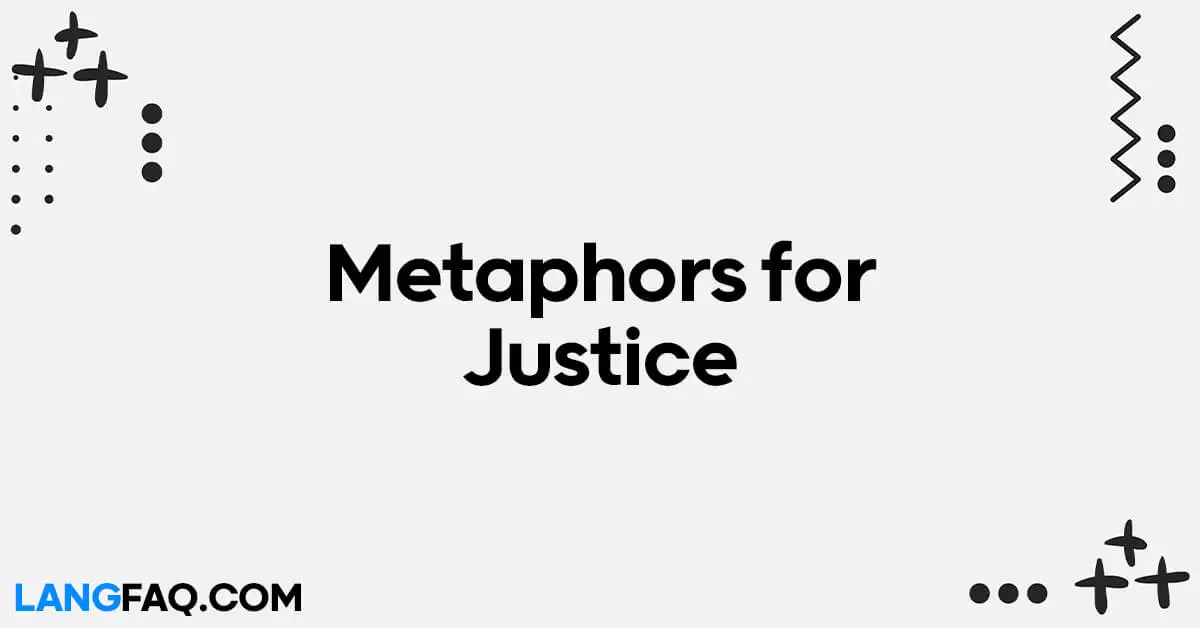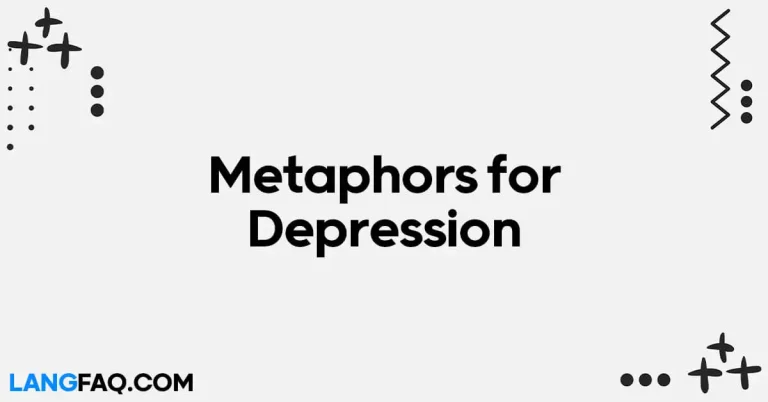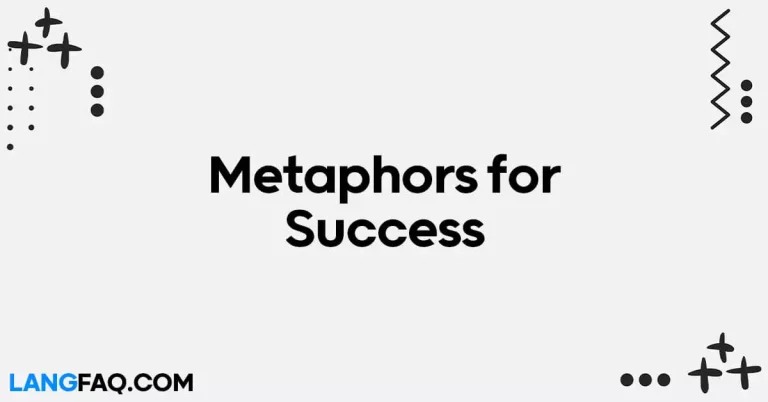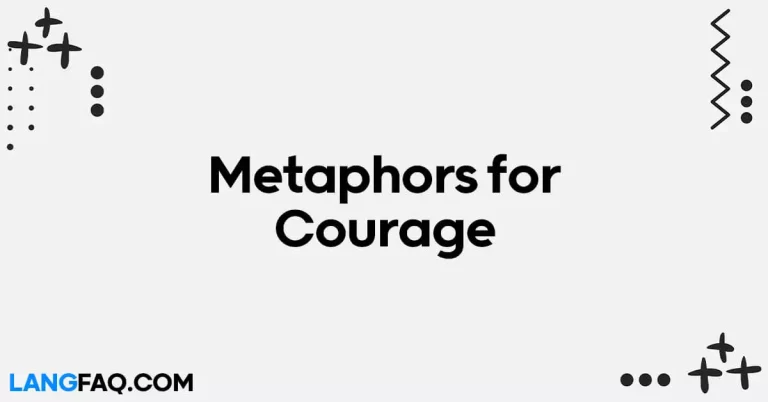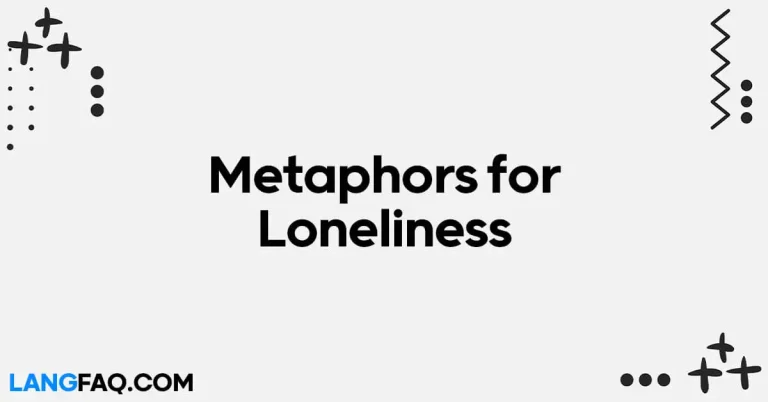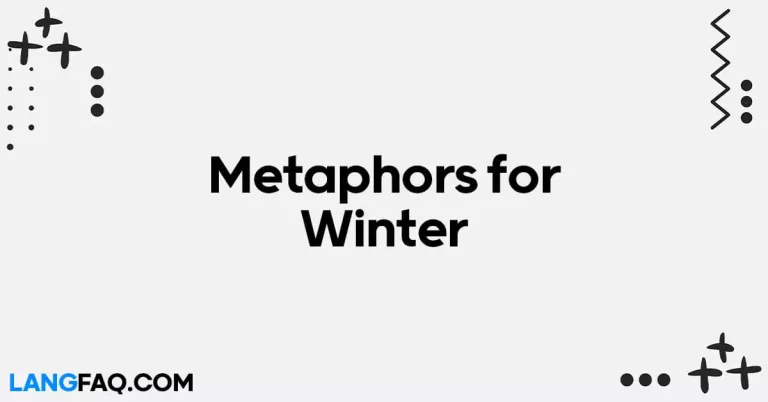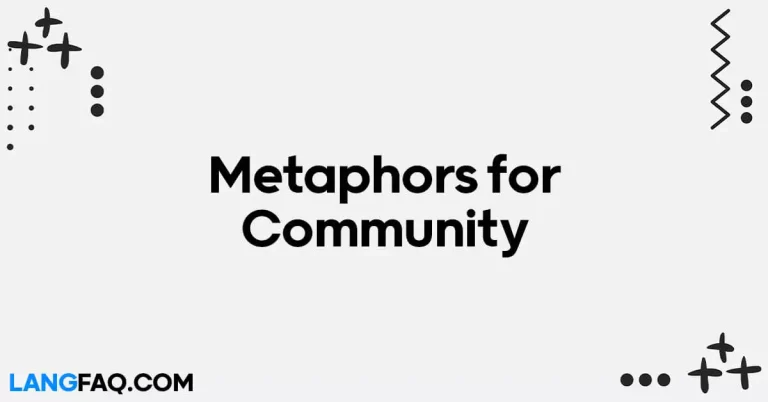Justice, an intangible concept seeking equilibrium, is often metaphorically portrayed in the intricate language of law. This article dives into the realm of “Metaphors for Justice,” unraveling the symbolic language that intertwines with our legal discourse. Each metaphor tells a story, reflecting the ideals and challenges embedded in the pursuit of fairness and equity.
26 Metaphors for Justice
- The Balancing Act: Justice as a delicate equilibrium where evidence and arguments are weighed on the scales of fairness.
- The Blindfolded Guardian: Symbolizing impartiality, Lady Justice wears a blindfold, ensuring unbiased judgment in legal proceedings.
- The Beacon of Truth: Justice as a guiding light that illuminates the path to truth and integrity.
- The Sword of Righteousness: A metaphorical sword wielded to cut through deception and uphold the principles of fairness.
- The Healing Balm: Justice as a soothing remedy that brings relief and resolution to those affected by wrongdoing.
- The Architect of Equity: Building a just society through careful design, where each element contributes to fairness.
- The Watchful Sentinel: Justice as a vigilant guardian, ever-alert to protect the rights and liberties of individuals.
- The Harmonious Symphony: In legal proceedings, justice is the orchestration of various elements to create a harmonious resolution.
- The Fertile Soil: Cultivating justice, akin to nurturing the growth of fairness and equality in society.
- The Quenching Rain: Justice as a refreshing downpour that extinguishes the flames of injustice, restoring balance.
- The Nurturing Parent: Guiding and disciplining, justice plays the role of a caring parent, fostering a sense of responsibility.
- The Tapestry Weaver: Justice as the intricate weaving of societal threads, creating a fabric of fairness and accountability.
- The Mirror of Reflection: Reflecting society’s values, justice holds up a mirror that reflects the community’s principles and ethics.
- The Bridge Builder: Justice connects individuals and communities, fostering understanding and resolution.
- The Clear Waters: Justice, like pure and transparent waters, represents clarity and transparency in legal processes.
- The Compass Needle: Always pointing to true north, justice serves as a moral compass guiding individuals toward ethical conduct.
- The Gardener of Rights: Nurturing and safeguarding the rights of individuals, justice ensures a flourishing garden of freedoms.
- The Puzzle Solver: Justice as the meticulous fitting together of legal pieces, solving the puzzle of fairness.
- The Shield of Innocence: A protective shield guarding the innocent from unjust harm.
- The Metamorphosis: Justice, like a transformative force, has the power to change perspectives and societal norms.
- The Sculptor of Consequences: Justice sculpts outcomes, shaping consequences that align with ethical principles.
- The Beacon of Accountability: Shining a light on responsibility, justice fosters a sense of individual and collective accountability.
- The Compassionate Arbiter: Balancing the scales with compassion, justice tempers severity with understanding.
- The Symphony Conductor: Orchestrating a symphony of fairness, justice ensures that every note contributes to the harmonious whole.
- The Resolute Beacon: A steadfast beacon guiding society through storms, representing justice’s resilience in challenging times.
- The Sun on the Horizon: Justice as the rising sun, promising a new day of fairness, equality, and ethical conduct.
| Metaphor | Meaning and Examples |
|---|---|
| The Balancing Act | Justice involves delicate equilibrium, where evidence and arguments are weighed fairly. |
| The Blindfolded Guardian | Symbolizing impartiality, Lady Justice wears a blindfold, ensuring unbiased judgment. |
| The Beacon of Truth | Justice serves as a guiding light, illuminating the path to truth and integrity. |
| The Sword of Righteousness | A metaphorical sword cuts through deception, upholding the principles of fairness. |
| The Healing Balm | Justice is a soothing remedy, bringing relief and resolution to those affected by wrongdoing. |
| The Architect of Equity | Building a just society through careful design, where each element contributes to fairness. |
| The Watchful Sentinel | Justice acts as a vigilant guardian, ever-alert to protect the rights and liberties of individuals. |
| The Harmonious Symphony | In legal proceedings, justice orchestrates various elements to create a harmonious resolution. |
| The Fertile Soil | Cultivating justice, akin to nurturing the growth of fairness and equality in society. |
| The Quenching Rain | Justice is a refreshing downpour that extinguishes the flames of injustice, restoring balance. |
| The Nurturing Parent | Justice plays the role of a caring parent, guiding and disciplining to foster a sense of responsibility. |
| The Tapestry Weaver | Justice is the intricate weaving of societal threads, creating a fabric of fairness and accountability. |
| The Mirror of Reflection | Reflecting society’s values, justice holds up a mirror that shows the community’s principles and ethics. |
| The Bridge Builder | Justice connects individuals and communities, fostering understanding and resolution. |
| The Clear Waters | Justice, like pure and transparent waters, represents clarity and transparency in legal processes. |
| The Compass Needle | Justice serves as a moral compass, always pointing to true north and guiding individuals toward ethical conduct. |
| The Gardener of Rights | Nurturing and safeguarding the rights of individuals, justice ensures a flourishing garden of freedoms. |
| The Puzzle Solver | Justice is the meticulous fitting together of legal pieces, solving the puzzle of fairness. |
| The Shield of Innocence | A protective shield guards the innocent from unjust harm. |
| The Metamorphosis | Justice, like a transformative force, has the power to change perspectives and societal norms. |
| The Sculptor of Consequences | Justice sculpts outcomes, shaping consequences that align with ethical principles. |
| The Beacon of Accountability | Shining a light on responsibility, justice fosters a sense of individual and collective accountability. |
| The Compassionate Arbiter | Balancing the scales with compassion, justice tempers severity with understanding. |
| The Symphony Conductor | Orchestrating a symphony of fairness, justice ensures that every note contributes to the harmonious whole. |
| The Resolute Beacon | A steadfast beacon guiding society through storms, representing justice’s resilience in challenging times. |
| The Sun on the Horizon | Justice, like the rising sun, promises a new day of fairness, equality, and ethical conduct. |
These metaphors for justice paint a vivid tapestry of its multifaceted nature. From the delicate balance of scales to the guiding light of truth, each metaphor offers a unique perspective on the principles that underpin fairness and equity.
Whether justice is portrayed as a nurturing force, a transformative power, or a vigilant guardian, these metaphors collectively reinforce the importance of a just society. Like threads woven into a fabric, these symbols not only reflect but also shape our understanding of justice, reminding us of its enduring role in fostering a harmonious and accountable community.
The Equilibrium Duet: Balancing Act in Legal Proceedings
In the intricate dance of justice, the term “Balancing Act” emerges as a resonant metaphor. This phrase encapsulates the delicate equilibrium required when weighing evidence and arguments on the scales of fairness. Imagine Lady Justice gracefully holding these scales, symbolizing the careful balancing act inherent in every legal decision.
Definition and Usage:
Formal Context: In legal discourse, the term “Balancing Act” is often employed to describe the meticulous consideration of competing interests in a case. It underscores the importance of fair and impartial judgment.
Informal Context: Outside the courtroom, this metaphor can be used in conversations about making difficult decisions or finding harmony in conflicting situations.
Example Sentence:
Formal: The judge’s role is akin to a masterful conductor, orchestrating the delicate balancing act of legal principles.
Informal: Deciding between work commitments and personal life can feel like a constant balancing act.
Grammar Insight:
When using “Balancing Act” in a sentence, it often pairs with verbs like “perform,” “execute,” or “navigate,” emphasizing the active and skillful nature of maintaining equilibrium.
Tips:
When discussing legal matters or decisions that require careful consideration, integrating the term “Balancing Act” adds a nuanced layer to your expression, emphasizing the complexity involved.
The Oath of Impartiality: The Blindfolded Guardian Unveiled
The metaphorical “Blindfolded Guardian” in legal iconography represents the impartiality expected in judicial proceedings. Her covered eyes serve as a powerful symbol, emphasizing the commitment to assessing cases without bias.
Definition and Usage:
Formal Context: Within legal discussions, the “Blindfolded Guardian” metaphor is employed to highlight the judiciary’s dedication to objective decision-making, devoid of personal prejudices.
Informal Context: In everyday conversations, this metaphor can be invoked to underscore the importance of remaining impartial in resolving disputes.
Example Sentence:
Formal: The judge, much like the Blindfolded Guardian, must render judgments without letting personal beliefs sway the decision.
Informal: When mediating conflicts, try to be the Blindfolded Guardian—neutral and unbiased.
Grammar Insight:
When using this metaphor, verbs like “embody,” “symbolize,” or “represent” are commonly utilized to connect the concept to a person or entity.
Tips:
Applying the “Blindfolded Guardian” metaphor can be especially impactful when discussing fairness, ethics, or the need for objectivity, amplifying the gravity of the subject matter.
The Guiding Light of Truth: Justice Illuminated
“Beacon of Truth” serves as a compelling metaphor, portraying justice as a guiding light that illuminates the path to truth and integrity. It encapsulates the idea that justice exposes reality and dispels darkness.
Definition and Usage:
Formal Context: In legal contexts, the “Beacon of Truth” is invoked to underscore the role of justice in revealing the facts and uncovering the truth in legal proceedings.
Informal Context: In casual conversations, this metaphor can be employed to highlight the importance of honesty and transparency in personal relationships.
Example Sentence:
Formal: The court serves as a Beacon of Truth, uncovering the facts and ensuring a just resolution.
Informal: In friendships, always strive to be a Beacon of Truth, even when the truth is uncomfortable.
Grammar Insight:
When using this metaphor, verbs like “reveal,” “illuminate,” or “expose” can be employed to emphasize the role of justice in bringing clarity.
Tips:
Integrate the “Beacon of Truth” metaphor when discussing the pursuit of honesty and transparency. It adds a vivid and powerful dimension to the conversation.
The Sword of Righteousness: Cutting Through Injustice
Symbolizing authority and the power to enforce the law, the “Sword of Righteousness” metaphor embodies the idea of cutting through deception and upholding the principles of fairness.
Definition and Usage:
Formal Context: In legal discourse, this metaphor is employed to describe the authoritative role of justice in punishing wrongdoing and maintaining order.
Informal Context: In everyday conversations, it can be used to emphasize the need for swift and just resolutions in personal or professional matters.
Example Sentence:
Formal: The judiciary, with its Sword of Righteousness, ensures that justice is not only served but seen to be served.
Informal: Sometimes, in friendships, you need to wield the Sword of Righteousness and confront issues head-on for a fair resolution.
Grammar Insight:
When using this metaphor, verbs like “wield,” “enforce,” or “uphold” help convey the sense of authority and action associated with the Sword of Righteousness.
Tips:
Employ the “Sword of Righteousness” metaphor when discussing the need for justice to be proactive, ensuring that wrongdoing is swiftly addressed and rectified.
The Soothing Remedy: Healing Balm of Justice
In the complex realm of justice, the metaphor “Healing Balm” conveys the idea that justice acts as a soothing remedy, bringing relief and resolution to those affected by wrongdoing.
Definition and Usage:
Formal Context: Within legal contexts, the “Healing Balm” metaphor emphasizes the reparative nature of justice, focusing on the restoration of rights and redress for victims.
Informal Context: In personal conversations, this metaphor can be used to highlight the calming and resolving impact of addressing conflicts justly.
Example Sentence:
Formal: Legal reparations serve as a Healing Balm, mitigating the harm caused by injustices.
Informal: In relationships, seeking understanding can be the Healing Balm that soothes emotional wounds.
Grammar Insight:
Verbs like “mitigate,” “alleviate,” or “provide solace” are effective when conveying the Healing Balm metaphor.
Tips:
When discussing the transformative power of justice, integrating the “Healing Balm” metaphor adds depth to the conversation, emphasizing its capacity to bring closure and relief.
The Architect of Equity: Designing Fair Societal Structures
“Architect of Equity” portrays justice as an intentional designer, building a just society through careful planning where each element contributes to fairness.
Definition and Usage:
Formal Context: In legal and policy discussions, the “Architect of Equity” metaphor is used to highlight the intentional structuring of laws and systems to promote fairness.
Informal Context: In everyday conversations, it can be employed to underscore the importance of intentionally creating fair environments.
Example Sentence:
Formal: The legislature acts as the Architect of Equity, crafting laws that ensure fairness for all citizens.
Informal: In community initiatives, strive to be the Architect of Equity, considering the needs of everyone involved.
Grammar Insight:
Verbs like “craft,” “design,” or “construct” are effective in conveying the intentional and planned nature of being the Architect of Equity.
Tips:
When discussing the intentional creation of fair systems, incorporating the “Architect of Equity” metaphor emphasizes the importance of thoughtful design.
The Watchful Sentinel: Ever-Vigilant Guardian of Rights
As a metaphor, “Watchful Sentinel” paints a picture of justice as a vigilant guardian, always alert to protect the rights and liberties of individuals.
Definition and Usage:
Formal Context: Within legal discussions, the “Watchful Sentinel” metaphor is invoked to underscore the continuous monitoring and protection of individual rights.
Informal Context: In everyday conversations, it can be used to highlight the importance of staying vigilant against potential infringements on personal freedoms.
Example Sentence:
Formal: Constitutional rights act as a Watchful Sentinel, ensuring protection even in the face of evolving legal landscapes.
Informal: In personal relationships, be the Watchful Sentinel of your boundaries, ensuring they are respected.
Grammar Insight:
Verbs like “protect,” “monitor,” or “safeguard” are effective when emphasizing the active role of the Watchful Sentinel.
Tips:
Integrating the “Watchful Sentinel” metaphor amplifies discussions about the continuous protection of rights, serving as a powerful visual representation of legal guardianship.
The Harmonious Symphony: Orchestrating Fair Legal Resolutions
In the legal realm, the “Harmonious Symphony” metaphor portrays justice as the conductor of a symphony, orchestrating various elements to create a harmonious and just resolution.
Definition and Usage:
Formal Context: Legal scholars may use the “Harmonious Symphony” metaphor to depict the intricate coordination required for fair legal proceedings.
Informal Context: In casual conversations, this metaphor can be employed to emphasize the collaborative efforts needed for just outcomes.
Example Sentence:
Formal: In complex litigation, the judge acts as the conductor, orchestrating a Harmonious Symphony of legal arguments.
Informal: Resolving disputes in a family requires everyone to play their part in the Harmonious Symphony of communication.
Grammar Insight:
Verbs like “orchestrate,” “coordinate,” or “blend” are effective in conveying the collaborative nature of the Harmonious Symphony.
Tips:
When discussing the collaborative nature of legal processes, incorporating the “Harmonious Symphony” metaphor adds a rich layer to the conversation, highlighting the need for coordination.
The Cultivated Garden: Nurturing Growth of Fairness
In the metaphorical landscape of justice, “Cultivated Garden” signifies justice as a nurturer, cultivating the growth of fairness and equality in society.
Definition and Usage:
Formal Context: Within legal and policy discussions, the “Cultivated Garden” metaphor emphasizes intentional efforts to foster fairness and equality in legal systems.
Informal Context: In everyday conversations, it can be used to encourage individuals to actively contribute to creating fair and inclusive environments.
Example Sentence:
Formal: Legislative reforms act as the Cultivated Garden, promoting the growth of equity in societal structures.
Informal: In workplace dynamics, strive to be the Cultivated Garden, fostering an inclusive and fair atmosphere.
Grammar Insight:
Verbs like “promote,” “foster,” or “cultivate” effectively convey the intentional and nurturing aspects of the Cultivated Garden metaphor.
Tips:
When discussing the intentional cultivation of fairness and equality, incorporating the “Cultivated Garden” metaphor adds depth to the conversation, emphasizing the need for proactive efforts.
The Refreshing Downpour: Quenching Injustice’s Flames
“Refreshing Downpour” as a metaphor portrays justice as rain, quenching the flames of injustice and restoring balance to society.
Definition and Usage:
Formal Context: In legal discourse, the “Refreshing Downpour” metaphor is used to describe legal actions that rectify injustices and restore balance.
Informal Context: In personal conversations, it can be employed to convey the importance of addressing and rectifying imbalances.
Example Sentence:
Formal: Legal reforms serve as a Refreshing Downpour, extinguishing the flames of systemic injustice.
Informal: In friendships, addressing conflicts head-on can be the Refreshing Downpour needed for healing.
Grammar Insight:
Verbs like “rectify,” “restore,” or “address” are effective when using the Refreshing Downpour metaphor.
Tips:
When discussing the rectification of imbalances or the restoration of justice, incorporating the “Refreshing Downpour” metaphor brings a vivid and impactful visual element to the conversation.
The Nurturing Mentor: A Guiding Hand in Legal Matters
In the intricate world of justice, envisioning justice as a “Nurturing Mentor” brings forth the idea of guiding and disciplining to foster a sense of responsibility.
Definition and Usage:
Formal Context: In legal and educational settings, the “Nurturing Mentor” metaphor can be used to describe the role of mentors or legal guides in shaping responsible legal professionals.
Informal Context: In everyday conversations, this metaphor can be applied to emphasize the importance of mentorship in personal and professional growth.
Example Sentence:
Formal: Seasoned judges often serve as Nurturing Mentors, guiding young legal professionals toward ethical practice.
Informal: In career development, find a Nurturing Mentor who can provide guidance and insights.
Grammar Insight:
Verbs like “guide,” “shape,” or “mentor” effectively convey the supportive and educational aspects of the Nurturing Mentor metaphor.
Tips:
When discussing mentorship in legal or professional contexts, integrating the “Nurturing Mentor” metaphor adds a layer of depth, emphasizing the supportive and educational role of mentors.
The Weaver of Societal Threads: Crafting Fairness in Fabric
In the tapestry of societal values, “Weaver of Societal Threads” symbolizes justice as the intricate craftsperson, creating a fabric woven with fairness and accountability.
Definition and Usage:
Formal Context: Within legal and sociological discussions, the “Weaver of Societal Threads” metaphor can be used to describe the intentional creation of fair and accountable societal structures.
Informal Context: In everyday conversations, it can be applied to emphasize the collective responsibility in shaping fair communities.
Example Sentence:
Formal: Policy makers act as the Weaver of Societal Threads, crafting laws that interlace fairness and accountability.
Informal: In community initiatives, each member becomes a Weaver of Societal Threads, contributing to a fair and just society.
Grammar Insight:
Verbs like “craft,” “interlace,” or “shape” are effective in conveying the intentional and collaborative nature of societal crafting.
Tips:
When discussing the intentional creation of fair communities or societal structures, integrating the “Weaver of Societal Threads” metaphor adds a visual and collaborative dimension to the conversation.
The Reflective Mirror: Insight into Societal Values
In the realm of justice, the metaphor “Reflective Mirror” signifies justice as a mirror, reflecting societal values and ethics.
Definition and Usage:
Formal Context: Within legal and ethical discussions, the “Reflective Mirror” metaphor is employed to describe how legal systems mirror societal values and ethical standards.
Informal Context: In everyday conversations, it can be used to emphasize the interconnectedness between individual values and broader societal norms.
Example Sentence:
Formal: Legal decisions often act as a Reflective Mirror, mirroring the prevailing values and ethics of a society.
Informal: In personal choices, individuals become the Reflective Mirror, embodying the values they uphold.
Grammar Insight:
Verbs like “mirror,” “embody,” or “reflect” convey the interconnected nature of justice and societal values in the Reflective Mirror metaphor.
Tips:
When discussing the alignment of legal decisions with societal values, incorporating the “Reflective Mirror” metaphor adds a visual and reflective element to the conversation, underscoring the symbiotic relationship.
The Bridging Architect: Connecting Individuals and Communities
The metaphor “Bridging Architect” portrays justice as an architect building bridges, connecting individuals and fostering understanding for a harmonious resolution.
Definition and Usage:
Formal Context: In legal and sociological contexts, the “Bridging Architect” metaphor is employed to describe the role of justice in connecting diverse perspectives for fair and inclusive outcomes.
Informal Context: In everyday conversations, it can be applied to highlight the importance of understanding and bridging gaps in personal relationships.
Example Sentence:
Formal: Mediation serves as the Bridging Architect, connecting opposing parties for a mutually beneficial resolution.
Informal: In family dynamics, being the Bridging Architect means fostering understanding and connection.
Grammar Insight:
Verbs like “connect,” “mediate,” or “bridge” convey the active and facilitative nature of the Bridging Architect metaphor.
Tips:
When discussing the role of justice in connecting individuals or resolving conflicts, integrating the “Bridging Architect” metaphor adds a constructive and collaborative dimension to the conversation.
The Transparency of Clear Waters: Clarity in Legal Processes
In the metaphorical landscape of justice, envisioning justice as “Clear Waters” represents the need for transparency and clarity in legal processes.
Definition and Usage:
Formal Context: Within legal discourse, the “Clear Waters” metaphor is used to emphasize the importance of transparent legal procedures and clear communication.
Informal Context: In everyday conversations, it can be applied to highlight the significance of open and honest communication in personal relationships.
Example Sentence:
Formal: Legal transparency acts as Clear Waters, ensuring public trust in the justice system.
Informal: In friendships, maintaining Clear Waters means communicating openly and honestly.
Grammar Insight:
Verbs like “ensure,” “maintain,” or “promote” are effective in conveying the active and beneficial aspects of the Clear Waters metaphor.
Tips:
When discussing the importance of transparency in legal processes or open communication in personal relationships, incorporating the “Clear Waters” metaphor adds a visual and essential element to the conversation.
The Ethical Compass: Guiding Towards True North
In the metaphorical realm, “Ethical Compass” signifies justice as a compass, always pointing toward true north, guiding individuals toward ethical conduct.
Definition and Usage:
Formal Context: In legal and ethical discussions, the “Ethical Compass” metaphor is employed to describe the role of justice in guiding individuals toward morally upright behavior.
Informal Context: In everyday conversations, it can be applied to emphasize the importance of ethical decision-making in personal and professional realms.
Example Sentence:
Formal: The legal framework acts as the Ethical Compass, providing a guide for morally sound decision-making.
Informal: In business dealings, having a personal Ethical Compass ensures decisions align with one’s moral principles.
Grammar Insight:
Verbs like “guide,” “direct,” or “lead” are effective in conveying the active and instructive nature of the Ethical Compass metaphor.
Tips:
When discussing the guidance provided by justice in ethical decision-making, incorporating the “Ethical Compass” metaphor adds a moral and directional layer to the conversation.
The Guardian of Individual Rights: Shield of Innocence
In the metaphorical landscape of justice, envisioning justice as the “Shield of Innocence” symbolizes its role in protecting the innocent from unjust harm.
Definition and Usage:
Formal Context: Within legal discussions, the “Shield of Innocence” metaphor is invoked to describe the protective role of justice in preserving the rights of the innocent.
Informal Context: In everyday conversations, it can be applied to underscore the importance of safeguarding the rights of individuals in various situations.
Example Sentence:
Formal: Legal representation serves as the Shield of Innocence, ensuring the rights of the accused are protected.
Informal: In friendships, being a Shield of Innocence means standing up for your friends when unjustly accused.
Grammar Insight:
Verbs like “protect,” “defend,” or “uphold” effectively convey the active and protective nature of the Shield of Innocence metaphor.
Tips:
When discussing the protective role of justice in preserving individual rights, incorporating the “Shield of Innocence” metaphor adds a visual and powerful element to the conversation, emphasizing the duty to protect the innocent.
The Transformative Force: Metamorphosis of Perspectives
In the metaphorical realm, “Metamorphosis” signifies justice as a transformative force, capable of changing perspectives and societal norms.
Definition and Usage:
Formal Context: In legal and sociological contexts, the “Metamorphosis” metaphor is employed to describe the transformative impact of justice on societal views and norms.
Informal Context: In everyday conversations, it can be applied to highlight personal growth and changes in perspectives.
Example Sentence:
Formal: Landmark legal cases often lead to a Metamorphosis in societal attitudes toward particular issues.
Informal: In personal development, experiences can act as a Metamorphosis, reshaping how we view the world.
Grammar Insight:
Verbs like “reshape,” “transform,” or “alter” effectively convey the dynamic and changing nature of the Metamorphosis metaphor.
Tips:
When discussing the transformative power of justice in societal or personal contexts, incorporating the “Metamorphosis” metaphor adds a dynamic and impactful layer to the conversation.
The Sculptor of Consequences: Shaping Ethical Outcomes
As a metaphor, “Sculptor of Consequences” portrays justice as an artist, sculpting outcomes that align with ethical principles and legal standards.
Definition and Usage:
Formal Context: In legal discussions, the “Sculptor of Consequences” metaphor can be employed to describe the role of justice in shaping outcomes that reflect ethical considerations.
Informal Context: In everyday conversations, it can be applied to emphasize the accountability and responsibility associated with decision-making.
Example Sentence:
Formal: Legal judgments act as the Sculptor of Consequences, ensuring that outcomes align with ethical and legal standards.
Informal: In personal choices, each decision becomes a brushstroke of the Sculptor of Consequences, shaping the ethical fabric of our lives.
Grammar Insight:
Verbs like “shape,” “mold,” or “define” are effective when conveying the intentional and impactful nature of the Sculptor of Consequences metaphor.
Tips:
When discussing the ethical considerations in legal decisions or personal choices, incorporating the “Sculptor of Consequences” metaphor adds a visual and intentional dimension to the conversation.
The Beacon of Accountability: Shining Light on Responsibility
As a metaphor, the “Beacon of Accountability” symbolizes justice as a guiding light, shining on responsibility and holding individuals and institutions accountable for their actions.
Definition and Usage:
Formal Context: Within legal and ethical discussions, the “Beacon of Accountability” metaphor is employed to describe the illuminating role of justice in fostering individual and institutional responsibility.
Informal Context: In everyday conversations, it can be applied to underscore the importance of personal accountability.
Example Sentence:
Formal: Legal frameworks act as the Beacon of Accountability, illuminating the path of responsibility for all.
Informal: In teamwork, each team member can be a Beacon of Accountability, ensuring everyone takes responsibility for their tasks.
Grammar Insight:
Verbs like “illuminate,” “highlight,” or “underscore” convey the guiding and highlighting aspects of the Beacon of Accountability metaphor.
Tips:
When discussing responsibility and accountability in legal or personal contexts, incorporating the “Beacon of Accountability” metaphor adds a vivid and guiding element to the conversation.
The Compassionate Arbiter: Balancing Severity with Understanding
In the intricate dance of justice, envisioning justice as the “Compassionate Arbiter” conveys the idea of balancing the scales with compassion, tempering severity with understanding.
Definition and Usage:
Formal Context: Within legal discussions, the “Compassionate Arbiter” metaphor is invoked to describe the role of justice in considering individual circumstances with empathy.
Informal Context: In everyday conversations, it can be applied to underscore the importance of approaching conflicts with a compassionate and understanding mindset.
Example Sentence:
Formal: Judges often act as the Compassionate Arbiter, considering mitigating factors in sentencing for a just outcome.
Informal: In resolving disputes, strive to be a Compassionate Arbiter, understanding the emotions and perspectives of all parties involved.
Grammar Insight:
Verbs like “consider,” “temper,” or “balance” effectively convey the compassionate and balancing nature of the Compassionate Arbiter metaphor.
Tips:
When discussing the nuanced approach of justice in legal or personal conflicts, integrating the “Compassionate Arbiter” metaphor adds a humane and empathetic layer to the conversation.
The Symphony Conductor: Orchestrating Fairness in Legal Processes
In the metaphorical realm, envisioning justice as the “Symphony Conductor” signifies its role in orchestrating a symphony of fairness, ensuring that every legal note contributes to the harmonious whole.
Definition and Usage:
Formal Context: Legal scholars may use the “Symphony Conductor” metaphor to depict the meticulous coordination required for fair legal proceedings.
Informal Context: In everyday conversations, it can be applied to highlight the collaborative efforts needed for just outcomes.
Example Sentence:
Formal: Legal professionals act as the Symphony Conductor, ensuring that each legal argument contributes to the harmonious resolution of a case.
Informal: Resolving conflicts in a community requires everyone to play their part in the Symphony Conductor’s orchestra of fairness.
Grammar Insight:
Verbs like “orchestrate,” “coordinate,” or “blend” are effective in conveying the collaborative and harmonious nature of the Symphony Conductor metaphor.
Tips:
When discussing the collaborative nature of legal processes, incorporating the “Symphony Conductor” metaphor adds a constructive and musical dimension to the conversation.
The Pillar of Integrity: Upholding Trust in Legal Systems
In the metaphorical architecture of justice, envisioning justice as the “Pillar of Integrity” symbolizes its foundational role in upholding trust and ethical standards within legal systems.
Definition and Usage:
Formal Context: Within legal discussions, the “Pillar of Integrity” metaphor is employed to describe the integral role of justice in maintaining trust and ethical conduct.
Informal Context: In everyday conversations, it can be applied to emphasize the importance of personal and professional integrity.
Example Sentence:
Formal: Legal institutions act as the Pillar of Integrity, ensuring that ethical standards are upheld to maintain public trust.
Informal: In personal and professional interactions, strive to be a Pillar of Integrity, fostering trust through ethical behavior.
Grammar Insight:
Verbs like “maintain,” “uphold,” or “foster” are effective in conveying the foundational and trust-building nature of the Pillar of Integrity metaphor.
Tips:
When discussing the importance of trust and ethical standards in legal or personal contexts, incorporating the “Pillar of Integrity” metaphor adds a visual and foundational element to the conversation.
The Guardian of Equity: Ensuring Fairness in Legal Proceedings
As a metaphor, the “Guardian of Equity” signifies justice as a vigilant guardian, ensuring fairness and equitable treatment for all individuals within legal proceedings.
Definition and Usage:
Formal Context: Within legal discourse, the “Guardian of Equity” metaphor is invoked to underscore the continuous monitoring and protection of fairness and equity.
Informal Context: In everyday conversations, it can be used to highlight the importance of ensuring fairness in personal and professional interactions.
Example Sentence:
Formal: The judiciary, acting as the Guardian of Equity, safeguards the principles of fairness and equitable treatment in legal proceedings.
Informal: In collaborative projects, each team member can be a Guardian of Equity, ensuring that everyone’s contributions are valued fairly.
Grammar Insight:
Verbs like “protect,” “monitor,” or “safeguard” are effective when emphasizing the active role of the Guardian of Equity.
Tips:
Integrating the “Guardian of Equity” metaphor amplifies discussions about the continuous protection of fairness and equitable treatment, serving as a powerful visual representation of legal guardianship.
The Maestro of Equality: Conducting the Symphony of Fairness
In the metaphorical symphony of justice, envisioning justice as the “Maestro of Equality” signifies its role in conducting a harmonious symphony of fairness, where every individual note contributes to an egalitarian composition.
Definition and Usage:
Formal Context: Legal scholars may use the “Maestro of Equality” metaphor to depict the meticulous coordination required for fair legal proceedings, ensuring equal treatment for all.
Informal Context: In everyday conversations, it can be applied to underscore the collaborative efforts needed to achieve a fair and just society.
Example Sentence:
Formal: Legal professionals, acting as the Maestro of Equality, ensure that every legal argument contributes to the harmonious and fair resolution of a case.
Informal: In fostering inclusivity, everyone becomes a Maestro of Equality, contributing to a society where fairness prevails.
Grammar Insight:
Verbs like “conduct,” “coordinate,” or “harmonize” effectively convey the collaborative and egalitarian nature of the Maestro of Equality metaphor.
Tips:
When discussing the collaborative nature of legal processes or the collective responsibility for fairness, incorporating the “Maestro of Equality” metaphor adds a constructive and musical dimension to the conversation.
The Mediator’s Bridge: Bridging Gaps in Understanding
The metaphor “Mediator’s Bridge” portrays justice as a bridge builder, fostering understanding and resolution by bridging gaps between conflicting parties.
Definition and Usage:
Formal Context: In legal and mediation discussions, the “Mediator’s Bridge” metaphor is employed to describe the role of justice in connecting diverse perspectives for fair and inclusive outcomes.
Informal Context: In everyday conversations, it can be applied to highlight the importance of mediation and understanding in resolving personal conflicts.
Example Sentence:
Formal: The mediator serves as the Mediator’s Bridge, facilitating communication and understanding for a mutually beneficial resolution.
Informal: In family dynamics, becoming a Mediator’s Bridge means fostering understanding and connection among family members.
Grammar Insight:
Verbs like “facilitate,” “connect,” or “bridge” convey the active and reconciliatory aspects of the Mediator’s Bridge metaphor.
Tips:
When discussing the role of justice in connecting individuals or resolving conflicts, integrating the “Mediator’s Bridge” metaphor adds a constructive and collaborative dimension to the conversation.
The Canvas of Justice: Painting a Picture of Fairness
As a metaphor, “Canvas of Justice” depicts justice as an artist, painting a vibrant picture of fairness, equity, and legal integrity.
Definition and Usage:
Formal Context: Within legal discourse, the “Canvas of Justice” metaphor is employed to describe the intentional creation of a legal landscape that embodies principles of fairness and equity.
Informal Context: In everyday conversations, it can be applied to emphasize the collective responsibility in shaping a just society.
Example Sentence:
Formal: Legal reforms act as the Canvas of Justice, where each stroke contributes to the portrayal of a fair and equitable legal system.
Informal: In community initiatives, each member becomes a painter on the Canvas of Justice, contributing to the creation of a just and inclusive society.
Grammar Insight:
Verbs like “paint,” “contribute,” or “shape” are effective in conveying the intentional and collaborative nature of the Canvas of Justice metaphor.
Tips:
When discussing the intentional creation of fair communities or societal structures, incorporating the “Canvas of Justice” metaphor adds a visual and collaborative dimension to the conversation.
The Torchbearer of Truth: Illuminating Dark Corners
In the metaphorical landscape of justice, envisioning justice as the “Torchbearer of Truth” symbolizes its role in shining a light on obscured facts, ensuring transparency and truth prevail.
Definition and Usage:
Formal Context: Within legal discussions, the “Torchbearer of Truth” metaphor is invoked to describe the role of justice in uncovering hidden facts and promoting transparency.
Informal Context: In everyday conversations, it can be used to emphasize the importance of honesty and transparency in personal relationships.
Example Sentence:
Formal: Legal investigations act as the Torchbearer of Truth, revealing concealed facts for a just and transparent legal process.
Informal: In personal dealings, be the Torchbearer of Truth, ensuring that open and honest communication prevails.
Grammar Insight:
Verbs like “reveal,” “uncover,” or “promote” effectively convey the active and illuminating nature of the Torchbearer of Truth metaphor.
Tips:
When discussing the importance of transparency in legal processes or open communication in personal relationships, incorporating the “Torchbearer of Truth” metaphor adds a visual and essential element to the conversation.
The Beacon of Hope: Guiding Towards Justice
In the metaphorical landscape, “Beacon of Hope” symbolizes justice as a guiding light, providing hope and direction for those seeking fairness and resolution.
Definition and Usage:
Formal Context: Within legal discussions, the “Beacon of Hope” metaphor is employed to describe the reassuring and guiding role of justice in legal processes.
Informal Context: In everyday conversations, it can be applied to emphasize the role of justice in providing hope and resolution in personal matters.
Example Sentence:
Formal: Legal proceedings act as the Beacon of Hope, providing reassurance and guidance to individuals seeking justice.
Informal: In personal challenges, view the legal system as a Beacon of Hope, offering resolution and a path forward.
Grammar Insight:
Verbs like “provide,” “guide,” or “reassure” convey the supportive and directional aspects of the Beacon of Hope metaphor.
Tips:
When discussing the reassuring role of justice in legal proceedings or personal challenges, incorporating the “Beacon of Hope” metaphor adds a positive and guiding element to the conversation.
The Weaving Hands of Fairness: Crafting Equitable Outcomes
As a metaphor, “Weaving Hands of Fairness” portrays justice as a skilled artisan, weaving intricate patterns to create outcomes that are fair and just.
Definition and Usage:
Formal Context: Within legal discourse, the “Weaving Hands of Fairness” metaphor is invoked to describe the intentional crafting of legal decisions that uphold principles of fairness.
Informal Context: In everyday conversations, it can be applied to emphasize the importance of intentional actions to create fair outcomes.
Example Sentence:
Formal: Judges act as the Weaving Hands of Fairness, carefully crafting legal decisions that uphold principles of equity.
Informal: In personal choices, strive to be the Weaving Hands of Fairness, ensuring that your actions contribute to fair and just outcomes.
Grammar Insight:
Verbs like “craft,” “uphold,” or “contribute” effectively convey the intentional and crafting nature of the Weaving Hands of Fairness metaphor.
Tips:
When discussing intentional actions in legal decisions or personal choices, integrating the “Weaving Hands of Fairness” metaphor adds a visual and intentional layer to the conversation.
FAQs
Q: How did the scales of justice become a symbol? The scales of justice trace their roots to ancient Egyptian mythology, where the goddess Maat used them to weigh the hearts of the deceased against a feather.
Q: Why is Lady Justice blindfolded? The blindfold symbolizes the objectivity required in legal proceedings. It ensures that judgments are based on facts and merit rather than personal biases.
Q: Is the sword of justice a global symbol? Yes, the sword as a symbol of justice transcends cultural boundaries, representing authority and the enforcement of law in various societies.
Q: Are metaphors for justice static or evolving? Metaphors for justice evolve with societal changes, reflecting shifts in perspectives on fairness, equality, and the role of the legal system.
Q: How do metaphors influence public perception of justice? Metaphors create a shared understanding of justice, shaping public perception and influencing attitudes toward the legal system.
Q: Are there cultures without metaphors for justice? While specific symbols may vary, nearly all cultures have metaphors or symbols representing justice, emphasizing its universal importance.
Conclusion
Metaphors for justice are more than linguistic embellishments; they’re windows into our collective understanding of fairness and equity. From the iconic scales and blindfolded lady to the authoritative sword, these metaphors shape how we perceive, pursue, and uphold justice. Embrace the richness of symbolism, for within these metaphors lies a profound reflection of our shared commitment to a just society.

